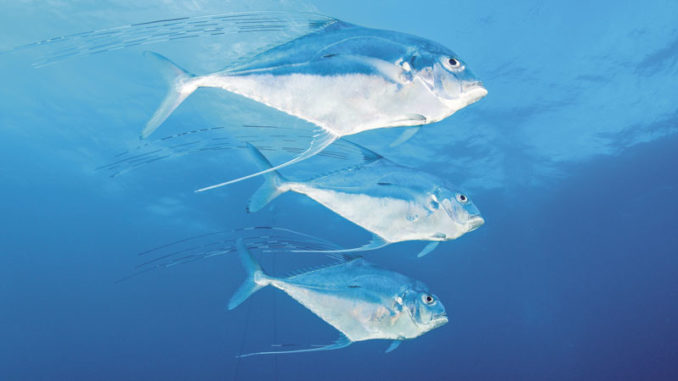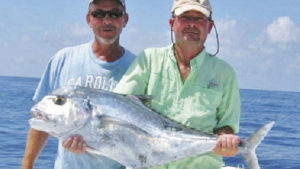
Offshore battlers are welcome in any angler’s boat but are rarely targeted
African pompano, Alectis ciliaris, are saltwater fish that are usually caught in deep, offshore waters around wrecks and artificial reefs. They are found in warmer oceans throughout the world, including the Gulf of Mexico, the Atlantic Ocean and the Pacific Ocean.
This species has a deceiving name. Though it bears a slight resemblance to Florida pompano, the African pompano is a member of the jack family, along with jack crevalles and amberjacks.
These fish have flattened bodies similar to those of Mahimahi and other jacks. They are silvery in color, with shimmering sides and a pattern of chevrons that range from very faint to quite dark. They have very blunt, steeply-sloped heads. They appear to have smooth skin with no scales, but they actually have many tiny, tightly-packed scales.
African pompano change fairly drastically as they age. When young, these fish have very long, thin, hair-like filaments growing from their dorsal and anal fins, filaments that are often longer than the fish itself. When flared, they give off an appearance similar to a jellyfish. Fisheries biologists believe this is to ward off predators until the fish is large enough to survive on its own. As the fish ages, the filaments disappear completely.
Juvenile African pompano are sometimes caught in estuaries along the coast, but they usually leave these areas at a fairly young age and move into deeper, offshore waters.

Weather watchers
Interestingly, these fish seem heavily influenced by adverse weather conditions. An example is when a major hurricane built off the coast of North Carolina in the mid-1990s. Before that storm, African pompano where considered a rare catch off the North Carolina coast, but a huge influx of the species was observed directly after that storm. And ever since then, these fish continue to show up in much bigger numbers than they ever did before the hurricane.
Anglers very rarely target African pompano specifically. However, they are welcomed by-catches of fishermen seeking snapper and grouper. And for anglers targeting those bottom species, African pompano are not a huge surprise, though fishermen are usually happy to catch them.
Their diets mostly consist of crab, shrimp and smaller fish. They are known to turn away food that is dead, seeming to prefer live food more strongly than most other species.
Louisiana’s state record for the species was caught by Michael Phillips off S. Timbalier Blk. in June 2003. That fish weighed 40.60 pounds.
The fish are known as great table fare, and they are hard fighters when hooked on rod and reel. The average size of these fish is 10 to 30 pounds, and they grow up to 50 pounds.